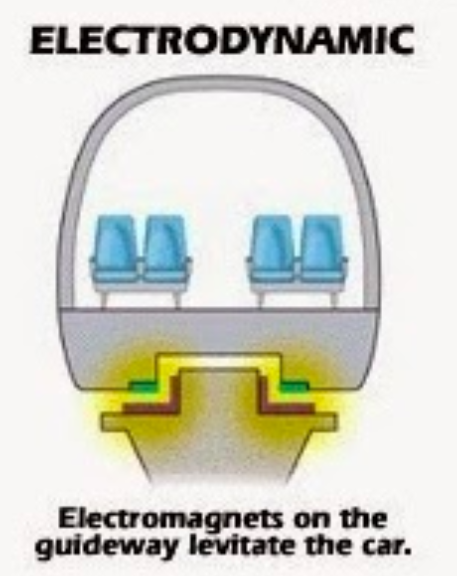Levitation, one of the key features of the hyperloop vision, is the phenomenon where the gravitational force on an object is counteracted by an upward force. The object is able to levitate without touching anything else (such as a floor or track). This is promising for the transportation industry since there is no contact between the moving object and the track eliminating friction. The hyperloop pod can levitate while transporting passengers from one place to another. Levitation can be realized in several ways, some of which will be addressed in this article.
Three methods for levitation briefly explained in this article are: electrodynamic suspension (EDS), electromagnetic suspension (EMS) and air bearings. Currently, no standard has been set on which levitation method to use for a future hyperloop. Companies and student teams are developing and innovating a variety of levitation mechanisms. This accelerates the innovation of these systems and the technology. However, the choice for a standard levitation system should be made eventually because they all require a different infrastructure.
Electrodynamic suspension (EDS) is based on repulsive electromagnetic forces. A conducting guideway/track will be required. The hyperloop pod is equipped with Halbach arrays on the bottom. Halbach arrays are magnets in a special configuration, focusing the magnetic field towards the track. When the pod moves with respect to the track, the conducting guideway will experience a change in magnetic field, because of the Halbach array moving with respect to the track. According to Faraday’s law of induction; a changing magnetic field induces electrical currents (eddy currents) within the conducting track. By Lenz’s law, the eddy currents in the track always creates a magnetic field that opposes the change in magnetic field which created the eddy currents in the first place. So, when the pod (with Halbach arrays) moves over the conducting track, an opposing magnetic field is created by the eddy currents, thus creating a lift force enabling levitation. The MLX01 Maglev in Japan uses EDS with superconducting electromagnets. Inductrack is a special form of EDS where magnets do not have to be superconductive. Room temperature magnets in combination with the Inductrack design are able to create a high Lift-to-Drag (L/D). See Figure 1 (left) for an illustration of EDS.
Click here for a demonstration of EDS
Electromagnetic suspension (EMS) is based on attractive magnetic forces. Two options that are currently being considered: a track on the ceiling of the tube and a maglev track (track on the bottom). The gap between the pod and the track is constantly measured. The gap distance can be altered by changing the strength of electromagnets (located on the vehicle). When the electromagnets get an increased current, a stronger magnetic field is created and the pod gets attracted to the ferromagnetic (e.g. electrical steel) track, reducing the gap distance. If the gap becomes too small, the sensors observe that and make sure the electromagnets become weaker. This system is inherently unstable and therefore a continuous feedback loop is required. Another guideway configuration is the Maglev (Transrapid design), where the pod has arms around the track, the principle works the same; using electromagnets to vary the gap between the pod and the track. See Figure 1 (right) for an illustration of EMS.
Figure 1. Left: simplistic example of an EDS system. Right: simplistic example of an EMS system.
Air bearings are the third possible levitation method, proposed by Elon Musk in the Alpha paper. The principle relies on compressed air that is released below the pod to create a layer of air on which the pod ‘surfs’. In order to maintain this for a long period of time (hyperloop routes could reach hundreds of kilometres), a compressor is required on the front of the pod. Air from the front of the pod will be compressed and released under the pod. The compressor will have high power consumption in order to create a sufficient levitation height. Moreover, fast rotating components are close to the passenger module so safety measurements have to be taken and a lot of maintenance is required because of the rotating components.

Figure 2: illustration of levitation using an air compressor
There are some parties rooting for a hyperloop without levitation; using traditional wheels. The wheels have to be able to handle large force at insane velocities. No (driving) wheels have been put into practice that survives that kind of loads, however, it is certainly not impossible. The maintenance required for the track and the wheels would be a challenge keeping in mind the vacuum environment. With a levitating hyperloop, no contact between objects is made, therefore maintenance will be significantly less.
For a future hyperloop, there has not been set a standard yet. However, the above certainly show potential.
By Delft Hyperloop, May 2019





0 Comments